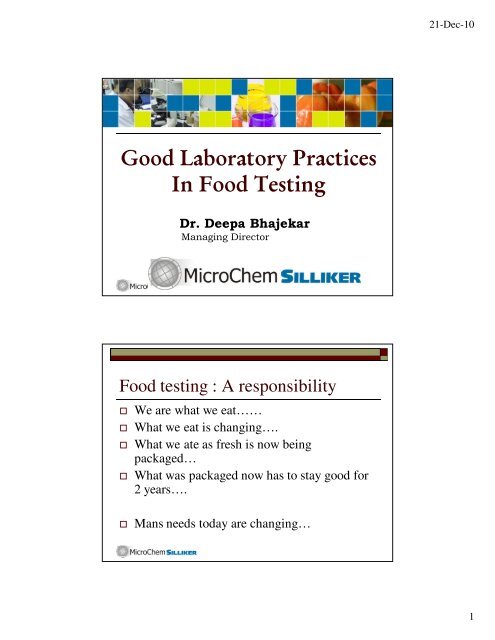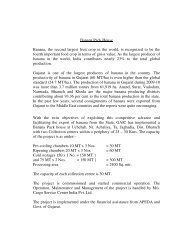Good Laboratory Practices In Food Testing Dr. Deepa Bhajekar
Good Laboratory Practices In Food Testing Dr. Deepa Bhajekar
Good Laboratory Practices In Food Testing Dr. Deepa Bhajekar
You also want an ePaper? Increase the reach of your titles
YUMPU automatically turns print PDFs into web optimized ePapers that Google loves.
21-Dec-10<strong>Good</strong> <strong>Laboratory</strong> <strong>Practices</strong><strong>In</strong> <strong>Food</strong> <strong>Testing</strong><strong>Dr</strong>. <strong>Deepa</strong> <strong>Bhajekar</strong>Managing Director<strong>Food</strong> testing : A responsibility We are what we eat…… What we eat is changing…. What we ate as fresh is now beingpackaged… What was packaged now has to stay good for2 years…. Mans needs today are changing…1
21-Dec-10SAFE FOODA SAFE FOOD may be definedas :“a product which is free ofmicrobiological, chemical orphysical hazards”.OR“a product that does not causeillness or injury when consumedas intended”.2
21-Dec-10<strong>Food</strong> Borne Diseases on the<strong>In</strong>creaseAvailable statistics on the incidence of foodborne diseases demonstrate that it is onincrease worldwide.Quality Assurance <strong>Food</strong> Quality(nutritional content, healthbenefits, etc.) <strong>Food</strong> Safety(absence of pathogens, toxins,allergens)3
21-Dec-10The implementation of any <strong>Food</strong> SafetyProgrambegins with a single most important attribute -ATTITUDE !!!Types of contamination PHYSICALhair, pins, staples, glass pieces, bindis, stones CHEMICALdisinfectants, cleaning agents MICROBIOLOGICALspoilage causing bacteria, yeasts and moulds4
21-Dec-10Early identification, Fast detection5
21-Dec-10GLP - DefnitionSet of principles that provides a frameworkwithin which laboratory studies are planned,performed, monitored, recorded, reported andarchived. - ISOGLP PrinciplesLab Design and <strong>In</strong>frastructureSelection of Suitable analytical methodsQualified equipmentsTrained Manpower<strong>Good</strong> Documentation6
21-Dec-10<strong>Laboratory</strong> Design & <strong>In</strong>frastructureSegregated lab for chemical, residue, micro labsControlled Environmental conditions – Temperature/ Humidity24 X 7 power back up<strong>Good</strong> House keeping Practice.Safety Measures – Fire Alarm, Fire Extinguisher,Eye washer, Emergency shower, emergency exit…Epoxy coating – Microbiology labChoice of Analytical Methods Standard methods published by AOAC,AACC, BIS, APHA, AOCS, ISO, EN, USFDA… <strong>In</strong>stument related methods – <strong>In</strong> housevalidation – LOD/ LOQ Quality control Samples & PerformanceCheck7
21-Dec-10Qualified Equipments Selection of equipments to meet the desirableSensitivity / accuracy ppm – ppb – ppt GC / HPLC – ppm GC MS / LC MS – ppb GC MS MS, LC MS MS, ICP MS, HR MS -pptManpower Minimum Qualification B.Sc Chemistry/B.Tech food science / technology Training Evaluation Authorization Periodical check / PT programmes QC Checks8
21-Dec-10Documentation Online documentation Entire analytical process to be traceable Starting from sample weighingreagent preparationpurity of standarddate of prep, date of expiry, Time/ date,log book entry, calibration of equipmentscalculation, verificationArchival of Samples / Datas Segregated Archival Room Date of receipt, date of analysis started,completed Date of disposal Regulatory conditions Perishable foods samples under refrigeration Retention time9
21-Dec-10Equipments – <strong>Food</strong> <strong>Testing</strong>LC MS MS – To determine Pesticideresidues, Melamine content, Sudan dyes,Penta chloro phenol, Aflatoins, NOTsGC MS MS - Pesticide residue, Methylmercury, Volatile organic compounds.AAS / ICP MS- Determination of Tracemetal analysis – Cadmium, Mercuy,Arsenic, Lead, Tin etcGC – Gas Chromatograph withECD/FID – Fatty acid profile,Cholesterol, Residual solvent10
21-Dec-10Equipments – <strong>Food</strong> ApplicationsHPLC – Vitamins – A, D2, D3,E, k1, K3 and Water solublevitamins – B1, B2, B3, B6 , B9,B12, <strong>Food</strong> Additives- Benzoicacids, BHA, BHT, TBHQ etc..FTIR – Identification ofcompounds, Mineral oilHR GC MS – DioxinsIon Chromatography – Aminoacids, water analysis11
21-Dec-10Microbiological Analysis in <strong>Food</strong>Total Bacterial CountAnaerobic SporeCountYeast & MouldColiformsEscherichia coliSalmonella spp.ShigellaPseudomonasaeruginosaStaphylococcus aureusClostridium perfringensClostridium botulinumFaecal StreptococciBacillus cereusBacillus subtilisVibrio choleraeVibrioparahaemolyticusChemical ContaminantsThese are chemicals that are present in theenvironment in which the food is grown,harvested, transported, stored, packagedand processed.12
21-Dec-10Chemical Safety - Global trendsand Issues …Chemical Residues – Pesticide, antibiotics, drugs,<strong>Food</strong> additives, POPs, PAH, PCP, PCBs, DioxinsAdulterants – Unauthorized preservatives, colours,chemicals (melamine in dairy products)<strong>Food</strong> Contact MaterialsToxic metals – Lead, Arsenic, Mercury, Cadmium<strong>Food</strong> Allergens<strong>Food</strong> AuthenticationsNutritional AnalysisCaloriesDietary fibreCalories from fatSugarsTotal fatProteinSaturated fatVitaminsTrans fatCalciumCholesterolIronSodiumMineralsTotal carbohydrates13
21-Dec-10Analytical techniques Chemical analysis Advanced <strong>In</strong>strumentation- Gas Chromatography- Liquid Chromatography- Mass Spectroscopy- SpectrophotometryNew-age contaminantsAcrylamideBenzeneDioxins and PCBsEthyl CarbamateNitrofuranPerchlorateRadionuclides14
21-Dec-10PesticidesTolerance limits for pesticide residues havebeen set by various regulatory authoritiesto protect us from harmful levels ofpesticides in food.Common varieties of Pesticides<strong>In</strong>secticides to control insectsRodenticides to control rodentsHerbicides to control weedsFungicides to control mold and fungusAntimicrobials to control bacteria15
21-Dec-10Heavy MetalsHeavy metals are contaminants that mayoccur as residues in food from theenvironment / industrial activities or fromfood processing.Common toxic metalcontaminantsLeadMercuryArsenicCadmiumCopperIronManganeseZincTinChromium16
21-Dec-10Naturally Occurring Toxins (NOTs)Not all toxins come from man-madesources. Many of these occur naturally arefound in food plants, mushrooms, shellfish, etc.Exotoxins & Mycotoxins<strong>In</strong> addition to disease caused by direct bacterialinfection, some foodborne illnesses are caused byExotoxins which are excreted by the cell as thebacterium growsMycotoxins are secondary metabolites producedby microfungi that are capable of causing diseaseand death in humans.17
21-Dec-10AllergensSome of the most common food allergens agents are :MilkEggPeanutsTree nutSeafoodShellfishSoyWheatAntibiotics & Veterinary <strong>Dr</strong>ugsAvoidance of antibiotic residues in food isessential in the production of safeproducts for human consumption18
21-Dec-10HormonesHormones that are artificiallyadministered to animals to increasegrowth, body mass or yield can beharmful to humans and their residualpresence need to be ascertained.Genetically Modified foodsGenetically Modified (GM) foods areproduced from genetically modifiedorganisms (GMO) which have had theirgenome altered through genetic engineeringtechniques19
21-Dec-10Accuracy of analysis20
21-Dec-10<strong>In</strong>terpretation of results21
21-Dec-10Thank You22






